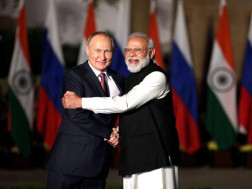Reports of new deals to sell French arms to India and Qatar are just the latest sign that France’s defence industry is gaining pace. The news comes as Russian arms exports decline in the wake of the war in Ukraine, leading to speculation that France could soon take its place as the world’s second-largest weapons exporter after the United States.
At this year’s Bastille Day military parade on July 14, French President Emmanuel Macron was joined by Indian Prime Minister Narendra Modi. It was also not just French forces on display. On the ground, Macron and his guest of honour watched as the Indian Tri-Services contingent made their way up the Champs-Élysées. In the air, the Indian Air Force performed a fly-past in French-made Dassault Rafale fighter jets.
To anyone closely following the international arms trade, this will not have come as a surprise. The day before, New Dehli gave initial approval for an order of six Scorpène submarines and 26 Rafale jets for the Indian Navy. Two weeks later on July 25, France’s La Tribune newspaper reported Qatar is considering adding another 24 Rafales to their stockpile.
Between 2018 and 2022, France’s share of the global arms trade increased to 11 percent compared with 7.1 percent over the previous four-year period, according to an annual Stockholm International Peace Research Institute (SIPRI) report published in March. In the same period, the Russian share of the international arms trade declined from 22 to 16 percent.
A review of orders late last year and so far in 2023 indicates this pattern is set to continue. “The trends are very clear for France,” said Pieter Wezeman, the author of the SIPRI report.
Even before India’s Rafale order in July, SIPRI’s assessment of outstanding orders for the most valuable weapons systems suggested France was making gains on Russia’s market share.
“For France, we have a total number of 210 combat aircraft [currently on order] and for Russia we only have 84,” Wezeman said. “These numbers can change, of course, but they do indicate that for sure France will remain a major arms exporter.”
The reasons for the decline in Russian arms sales are varied, although many are linked to the war in Ukraine. Countries naturally aim to diversify their suppliers. But Moscow’s invasion of Ukraine in February 2022 means it is now dedicating more of its arms supplies to the front line, holding on to certain arms systems and focusing on replacing weapons destroyed in battle.
Multiple rounds of international sanctions on Russia may have also affected its ability to secure the materials it needs for arms production, undermining its export capacity. Reports from the front lines in Ukraine have also damaged the reputation of Russia-built armaments.
The war has been “a humbling showcase for Russian military technology”, wrote Cullen Hendrix, an international affairs professor at the University of Denver, in a May contribution to Foreign Policy magazine. “Images of ‘headless’ tanks and reports of high failure rates for Russian missiles may be part wartime propaganda, part reality … Whatever the reasons, the war in Ukraine has not been a particularly compelling advertisement for Russia’s leading-edge military technology."
Some clients have also been disappointed with Russian products in recent years. As the world’s largest arms importer, India has a decades-long relationship with Russian arms suppliers. “India is not particularly happy with what they have received, in technical terms, from Russia,” Wezeman said. “So they have turned to France.”
Political considerations are also important, said Wezeman. “Since the beginning of the war [in Ukraine] India has been reluctant to increase or sustain military relations on a high level” with Moscow.
Moreover, the US “exerts a lot of power” on countries that procure their weapons from Russia, even before the Ukraine war, Wezeman said. Indonesia, for example, abandoned a Russian aircraft purchase in 2021, opting instead for US and French options.
But Russia still holds the lion's share of arms deals in Africa and with countries like Iran and China.
The Rafale: Is France a one-trick pony?
French-built Rafale fighter jets from Dassault Aviation have played a vital role in France’s recent success, says Olivier Gras, general secretary of EuroDéfense-France, a Paris-based association of civil and military officials.
In service as early as 2002, it took until 2015 before the Rafale was first exported. The twin-engine jets are now owned and operated by Greece, Qatar, India and Egypt and are soon expected to land in Croatia, Indonesia and the United Arab Emirates – which ordered 80 Standard F4 Rafales in 2021.
Rafale deliveries and orders globally have reached nearly 500, around half those of its main American competitor, Lockheed Martin’s F-35.
Other orders are also potentially in the pipeline. Colombia is closing in on a deal for 16 planes at the same time as Serbia – historically a client of Russia’s arms industry – is eyeing up 12 planes.
Beyond the political reasons for the Rafale’s rising popularity, Gras said the aircraft has also proved itself to be a “quality” and “versatile” fighter jet “that corresponds to the needs of pilots”, which is “quite rare among its competitors”.
And despite the Rafale being the “major contributor” to France’s success in the global arms race, Gras cited other successful military exports, notably the three defence and intervention frigates French company Navel Group signed with Greece in 2022.
Slow and steady rise
With the exception of Greece and Croatia, France has failed to make substantial gains in the European arms market despite the continent’s arms imports rising significantly since the start of the war in Ukraine.
Among European states that are members of NATO, there is a strong preference for the Lockheed Martin F-35 because of its capacity to drop US-made nuclear bombs.
But the stock price of Dassault Aviation has almost doubled since February 2022, when Russian invaded Ukraine. Asked whether the French arms industry is directly benefiting from the war in Ukraine, Gras said the matter was “delicate”, noting that the increase in French arms deals is the result of long-standing policy and predates the Russian invasion.
France overtook China as the world’s third-largest arms exporter in 2021. The 2022 SIPRI report documented France increasing its sales by 59 percent over the previous 10 years – more than any other country.
Whether France will surpass Russia as the world’s No. 2 arms exporter remains uncertain. Other suppliers, such as South Korea, are experiencing their own significant growth.
For his part, Wezeman thinks it’s a very real possibility. “It may be possible that in 2024, 2025 or 2026, France becomes equal to – or surpasses – Russian arms exports,” France24 reports.
















